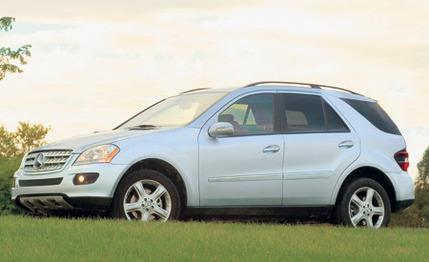 Short Take Road Test
Short Take Road Test
During the 1980s, one of the major objections to compression-ignition engines was noise. Sooty smoke and that peculiar exhaust aroma - call it eau de diesel - were also problems, but it was the noise that really turned heads. We were highly aware of these things at the time because then, as now, fuel economy was a major concern, and, as now, diesels seemed to be an answer.
A lot has changed since then. For one, the big concern of those energy-crisis times was the availability of fuel - remember those lines at the pump? - rather than its price. More important, soot, odor, and clatter have been removed from today's passenger-car diesels. And this Mercedes ML's new 3.0-liter V-6 turbo-diesel is a compelling case for quiet. Aside from a hint of rattle at startup, it's quiet across its entire power band. For contrast, the ML350 we tested in June 2005 blipped our sound meter to 43 dBA at idle and 71 dBA at full throttle. This ML320 came in at 42 and 69, respectively.
These noise distinctions seem very close, but remember that the decibel scale is logarithmic; the steps are steep. Think of the difference between having the London Philharmonic playing on your patio, then moving into the living room. It ain't subtle.
Although new to the U.S. market, this engine has been available in Europe since early '05, offered in a number of different Benzes: C-, E-, and R-classes, as well as M. It's a DOHC 24-valve 72-degree V-6, rather than the classic 60-degree layout, a design dictated by packaging considerations, and it uses a balance shaft to quell primary vibrations. Like all the latest automotive diesels, the V-6 is fed by a common-rail fuel system, whose mind-boggling line pressures - this one tops out at 1600 bar or 23,200 psi - create the fuel atomization required for complete combustion. The direct injection employs a single eight-orifice piezoelectric injector in each cylinder, delivering between two and five spritzes per power stroke, one of the keys to the engine's quiet operation. It's also clean - not a trace of soot in the tailpipe - although at this point it's legal in only 45 states.
The Garrett turbocharger, blowing through a Behr air-to-liquid intercooler, pumps up combustion-chamber pressure, with max boost listed at 1.45 bar or 21.0 psi. Peak horsepower is a modest 215 at 3800 rpm, but diesels are all about torque, and there's plenty of that: 398 pound-feet between 1400 and 2800 rpm, which is more than that of the 5.0-liter gas V-8 in the ML500. That's enough to get this 2.5-ton luxury SUV - 239 pounds heavier than the ML350 - to 60 mph in 8.1 seconds, a second slower than the 268-hp gasoline version.
Of course, diesels are also about fuel economy, and on this issue the jury's out. Mercedes talks about going from Detroit to New York - 639 miles - on one 25.1-gallon tank, but at the consumption rate we observed - 19 mpg - you'd wind up walking the last 162 miles. However, we were constrained by availability of ultra-low-sulfur fuel - required for the Benz's particulate filters - at the time of our test, so most of our driving was local, hasty, and urban.
Even so, 19 is 2 mpg better than we achieved with the ML350. And it's also worth noting that our man Gillies recorded more than 28 mpg driving an identical ML320 CDI in the U.K. last summer.
But one thing is certain: You'll never hear this one coming.